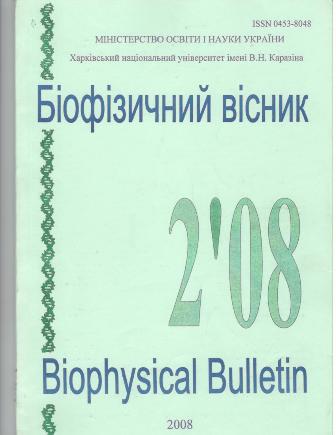Fluorescent probes in estimating the transmembrane potential changes of individual cells under effect of adrenaline
Abstract
The absolute values and amplitude of transmembrane potential changes in response to adrenaline have been determined in isolated rats hepatocytes by using fluorescent probe H 510 (3,3-diethiloxacarbocyanine bromide). The investigations have been carried out by the microfluorimetry method. The optimum images have been obtained on dyeing the cells with a probe of the minimum concentration 106 M. The transmembrane potential value was estimated at equilibrium probe concentrations from the fluorescence intensity of individual cells after proper digital processing of the photos by using a corresponding application package. To evaluate the potential values the Nernstian formula was adapted for the cationic fluorescent probes. The absolute value of transmembrane hepatocyte potential estimated was in the range of -48.3±6.9 mV. Adding the FCCP (250 нM) did not affect the value obtained (-46.4±2.7 mV), whereas the incubation of the cells in the potassium medium decreased the potential (-30.2±3.7 mV). The above data points that the parameters estimated present the absolute value of the transmembrane potential of the plasmatic hepatocyte membrane. Estimation of transmembrane potential changes from the fluorescence characteristics has revealed two phases of cellular reaction: ((140 мМ К+ ) depolarization by the 5th minute of adrenaline (10-6M) action on the cells and hyperpolarization by the 30th minute of the experiment at +10.3±2.55 mV and -10.0±1.83 mV, respectively. The hyperpolarization effect has not been also found under exposure to phenylephrine (10-6M) which confirms the need for activation of β-adrenoreceptors in order to realize the hyperpolarization hormone action. The data points to the high sensitivity of the carbocyanine probes used to the transmembrane potential changes
Downloads
References
315.
2. Plášsek J, Sigler K Slow fluorescent indicators of membrane potential: a survey of different approaches to
probe response analisis//Journal of Photochemistry and Photobiology B:Biology. -1996. Vol. 33, N2. P.101-124
3. Ákerman KE, Järvisalo JO. Effects of ionophores and metabolic inhibitors on the mitochondrial membrane
potential within isolated hepatocytes as measured with the safranine method//Biochem. J. 1980. Vol.192. P. 183-
190.
4. Новикова А.И., Макогон Н.В. мембранный потенциал как показатель гормонального эффекта у
животных разного возраста//Новые исследования по возрастной физиологии и биохимии, природе
гетерозиса и экологии животных. – Вестн. Харьк. ун-та, № 226. – Харьков: Вища школа. Изд-во при
Харьк. Ун-те, 1982. С.9-11.
5. Eherenberg B et al. Membrane potential can be determined in individual cells from the nernstian distribution
of cationic dyes//Biophys J. 1988. Vol. 53. N5.. P. 785-794.
6. ShapiroH.M. Membrane potential estimation by flow cytometry//Methods. 2000. Vol. 21. N 3. P. 271-279.
Authors who publish with this journal agree to the following terms:
- Authors retain copyright and grant the journal right of first publication with the work simultaneously licensed under a Creative Commons Attribution License that allows others to share the work with an acknowledgement of the work's authorship and initial publication in this journal.
- Authors are able to enter into separate, additional contractual arrangements for the non-exclusive distribution of the journal's published version of the work (e.g., post it to an institutional repository or publish it in a book), with an acknowledgement of its initial publication in this journal.
- Authors are permitted and encouraged to post their work online (e.g., in institutional repositories or on their website) prior to and during the submission process, as it can lead to productive exchanges, as well as earlier and greater citation of published work (See The Effect of Open Access).





